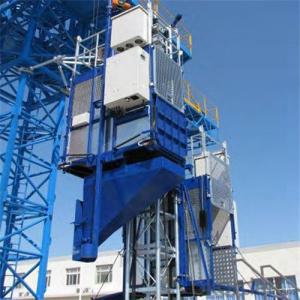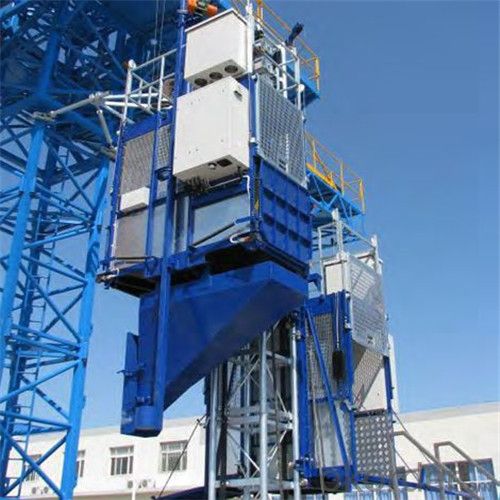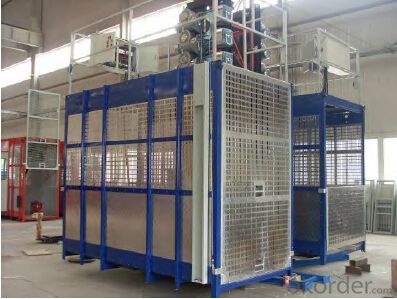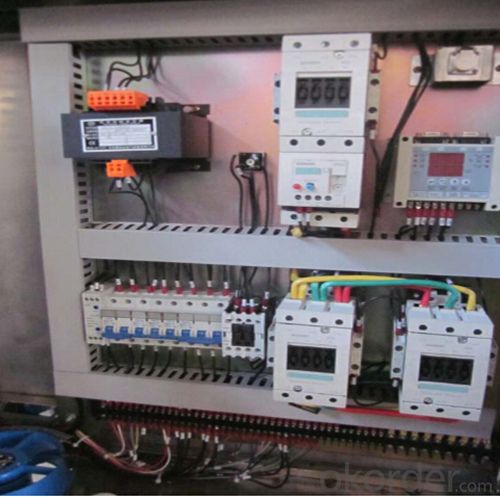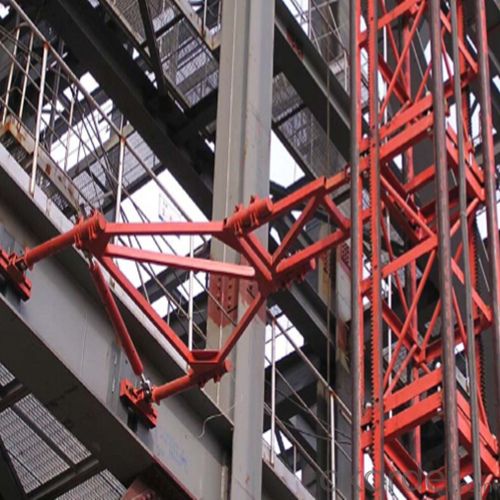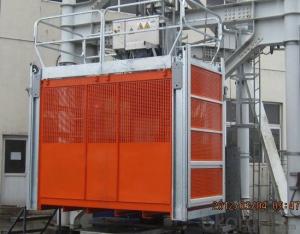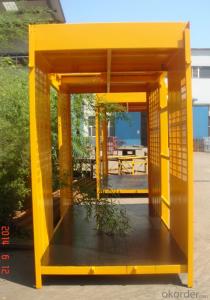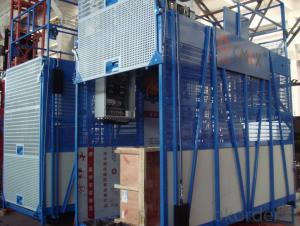Building Hoist SC100 with VF System, Current-restriction Function
- Loading Port:
- China main port
- Payment Terms:
- TT or LC
- Min Order Qty:
- 1 unit
- Supply Capability:
- 30 unit/month
OKorder Service Pledge
OKorder Financial Service
You Might Also Like
SC Hoist is a Rack and Pinion EL. Lift, used on construction site for transportation of personnel and materials. It is installed and dismounted conveniently and can grow as high as the buildings grow in height.
There are single cage and twin cage hoists. A single cage can be quickly transformed into twin cage hoist by adding a cage and other parts. The hoist payload can be increased by adding counterweight equipment.
SC Hoist has reliable electrical and mechanical safety device. It is a efficient and safety vertical transporting equipment.
Main Parts of Building Hoist
1. Adopts the most advanced VF speed control device and microcomputer programmable logic controller.
2. Stepless speed control helps eliminate the concussion during start up and braking, steady the operation process, and ensures automated leveling.
3. Adopts open loop V/Fcontrol; the speed control precision can reach ±2~3%. Realizes accurate low speed positioning of the hoist and avoid slipping during downward stopping of hoist.
4. The VF system has current-restriction function, ensuring a small current when motor start up and reducing the concussion to power supply. It reduces the engery consumption and mitigates effects to on site electric equipments.
5. The steadiness during running mitigates concussion to mechanical parts, reduces wears of rack, pinion and the brake and prolongs the spare parts'life.
6. The VF system also has the over voltage protection,low voltage protection, overcurrent, overload and anti-stalling protection functions,
7. The system applies the special software for hoists developed by our company, making the operation more safe and reliable.
Building Hoist images
CMAX Building Hoist
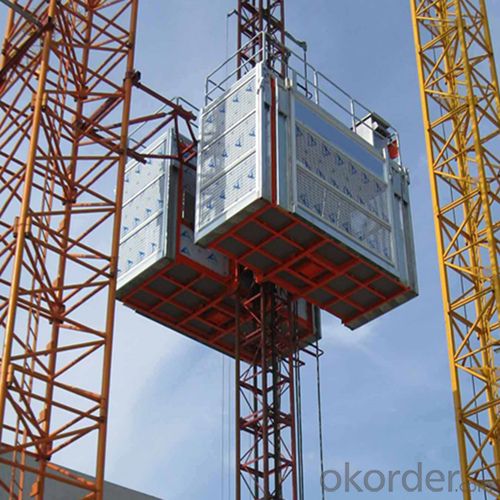
Anchorage System

Driving Unit
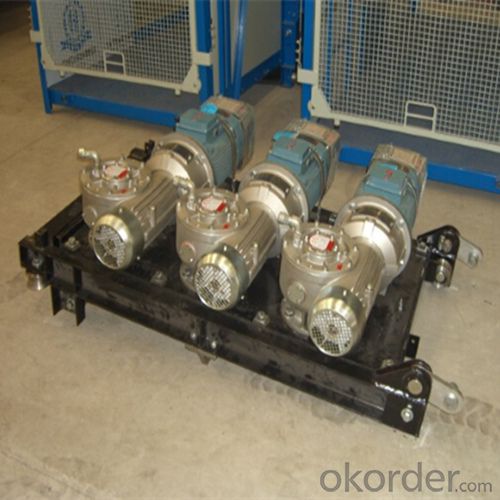
Warehouse
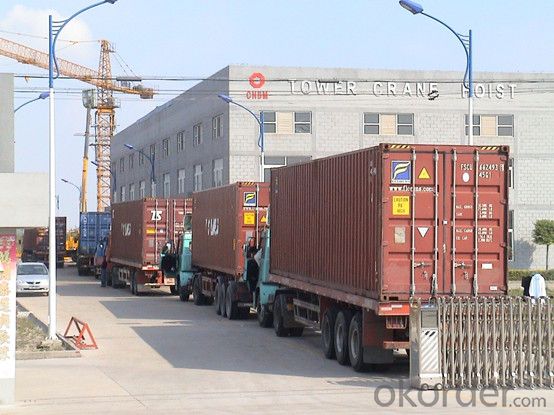
Building Hoist Specifiction
Main technical data | Unit | Value |
Rated load | kg | 1000 |
Rated erection load | kg | 1000 |
Jib attachment rated load | kg | 300 |
Cage size | m | 3.0×1.3×2.5 |
Maximum lifting height | m | 250 |
Lifting speed | m/min | 33 |
Rated output | kW | 2×11 |
Voltage rating | V | 380/440 |
Rated frequency | Hz | 50/60 |
Rated current | A | 2×23.5 |
Power supply fuses | A | 63 |
Protective class | / | IP55 |
Load duration factor | / | FC-25% |
Safety device | m/s | 1.2 |
Enclosure weight | kg | 980 |
Cage weight | kg | 1750 |
Counterweight | kg | / |
Mast section weight | kg | 125/145 |
Mast section length | mm | 1508 |
If you have special requirement on power, please state it when order the consignment.
We can produce the cage and lengthen the tie-in according to the size the customer requested.
We can heighten the erection height according to the customer’s request.
“/” means the item does not exist.
FAQ of Building Hoist
Q: What is the building hoist main purpose?
A: Building hoist equipped with double or single cabin to transport the materials and labors up and down. It's the ideal construction equipment for vertical transportation in the field of construction.
Q: What is the main structure of building hoist?
A: The P/M construction hoist mainly contains metal structure, driving system, electrical control system, cable guide & protection system, electrical top crane and safety device.
Q: What is the meaning of the building hoist’s code?
A: Take SC200/200 for example: “SC” stands for rack and pinion hoist, “200/200” stands for double cage and capacity is 2 tons per cage. “SC200” stands for single cage and capacity is 2 tons.
Q: What is the dimension of the cage?
A: Normally the cage dimension is 3X1.5X2.5M (L/W/H) for 2t type hoist. Details should be checked according to our quotation sheet. Also, the size can be customized according to the factual site condition. There are two doors (entrance & exit doors) for each cage, It can be produced as up & down sliding or ramping model for safety and convenience.
- Q: The construction elevator can not operate during the use of several stages of wind power
- The top wind speed is no more than 20m/s, which is level 8, the gale level 17.2-20.7 m/s, I am a tower crane and construction elevator accessories. I hope my answer will help you.
- Q: Is it permissible to use a building hoist for lifting people?
- <p>Building hoists are not designed for lifting people and doing so can be extremely dangerous. They are specifically engineered for the transportation of materials and equipment in construction settings. Using a building hoist to lift people violates safety regulations and can result in severe accidents. Always adhere to the manufacturer's guidelines and local safety laws, which prohibit the use of building hoists for carrying personnel.</p>
- Q: This question asks for the method to determine the maximum weight a building hoist can safely lift.
- <p>To calculate the load capacity of a building hoist, you must consider several factors. First, refer to the manufacturer's specifications for the hoist model in question, as they will provide the maximum load capacity. Check the hoist's mechanical components, such as the motor, cables, and pulleys, to ensure they are in good condition and can support the intended load. Factor in the weight of the materials to be lifted, including any containers or attachments. Consider the hoist's speed and lifting height, as these can affect stability and safety. Always adhere to safety regulations and never exceed the manufacturer's specified load capacity to prevent accidents and equipment damage.</p>
- Q: This question asks for the steps or methods to change the height at which a building hoist operates.
- <p>To adjust the height of a building hoist, follow these steps: Ensure the hoist is powered off and unplugged. Locate the height adjustment mechanism, which is typically a set of bolts or a telescoping system. Loosen any locking nuts or bolts to allow movement. Adjust the hoist height by raising or lowering the platform to the desired level. Once the correct height is reached, tighten the nuts or bolts to secure the hoist in place. Test the hoist to ensure it operates safely at the new height. Always refer to the manufacturer's instructions for specific details on your hoist model.</p>
- Q: This question asks for measures to protect lifting equipment from damage during its operation.
- <p>To prevent damage to lifting equipment during operation, ensure regular maintenance and inspection are conducted to check for wear and tear. Adhere to the equipment's load limits and never exceed them. Use appropriate lifting techniques and ensure the load is balanced. Keep the equipment clean and free from debris. Train operators thoroughly on safe operating procedures. Avoid sudden starts or stops, and ensure all safety features and guards are in place and functioning correctly. Regularly check cables, hooks, and other critical components for any signs of damage. Always follow the manufacturer's guidelines and industry safety standards.</p>
- Q: Can a building hoist experience technical issues or fail to operate properly?
- <p>Yes, a building hoist can malfunction. Like any mechanical system, hoists are subject to wear and tear, component failure, and can be affected by human error. Malfunctions may include mechanical breakdowns, electrical faults, or safety device failures. Regular maintenance, inspection, and adherence to safety protocols can reduce the risk of hoist malfunctions.</p>
- Q: This question asks if a building hoist can be set up either inside or outside a building.
- <p>Yes, a building hoist can be installed both indoors and outdoors. The choice between indoor and outdoor installation depends on the specific requirements of the construction project, the available space, and the building's design. Outdoor hoists are often used for high-rise construction, while indoor hoists are more common in multi-story buildings or where external space is limited. Both types require careful planning and adherence to safety regulations to ensure the safe and efficient movement of materials and personnel.</p>
- Q: What are alternative uses for a building hoist besides construction?
- <p>Yes, a building hoist can be used for purposes other than construction. It can be utilized for moving heavy equipment in industrial settings, transporting goods in warehouses, or even in emergency services for rescue operations. Its ability to lift and lower heavy loads makes it versatile for various applications where vertical transportation is required. However, it's crucial to ensure that any alternative use complies with safety regulations and the hoist's operational specifications.</p>
- Q: Is it possible for a building hoist to experience malfunctions that lead to damage?
- <p>Yes, a building hoist can malfunction and cause damage. Malfunctions can occur due to various reasons such as mechanical failure, operator error, or poor maintenance. These malfunctions can lead to accidents, including dropped loads, structural damage, or even injuries to workers. Regular inspections, proper maintenance, and adherence to safety protocols are crucial to minimize the risk of hoist malfunctions in construction settings.</p>
- Q: Is it safe to use a lifting device with someone who has no experience with it?
- <p>It is generally not advisable to use a lifting device with someone who is not familiar with it. Lifting devices require proper training and understanding of their operation to ensure safety. Using such equipment without proper knowledge can lead to accidents and injuries. It is crucial to ensure that anyone operating a lifting device has received the necessary training and is familiar with the specific device's safety protocols and operation procedures.</p>
Send your message to us
Building Hoist SC100 with VF System, Current-restriction Function
- Loading Port:
- China main port
- Payment Terms:
- TT or LC
- Min Order Qty:
- 1 unit
- Supply Capability:
- 30 unit/month
OKorder Service Pledge
OKorder Financial Service
Similar products
Hot products
Hot Searches
Related keywords
